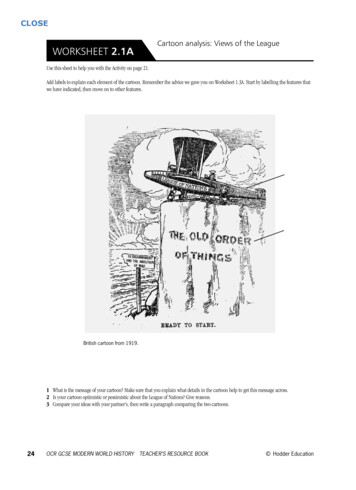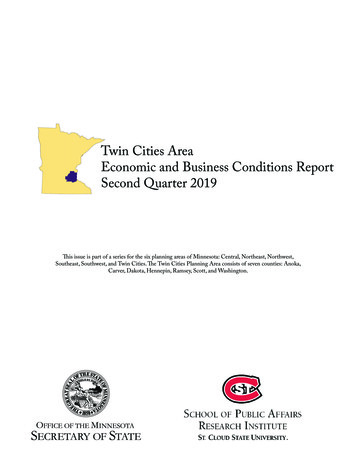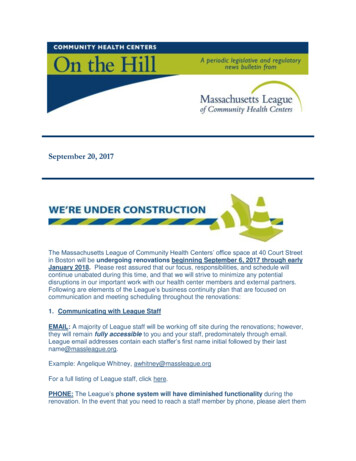
Transcription
NATIONALLEAGUEOF CITIESMicromobility in CitiesA HISTORY AND POLICY OVERVIEW
NATIONALLEAGUEOF CITIESAbout the National League of CitiesAbout the National League of Cities: The National League of Cities (NLC) is thenation’s leading advocacy organization devoted to strengthening and promotingcities as centers of opportunity, leadership and governance. Through its membershipand partnerships with state municipal leagues, NLC serves as a resource andadvocate for more than 19,000 cities and towns and more than 218 million Americans.NLC’s Center for City Solutions provides research and analysis on key topics andtrends important to cities and creative solutions to improve the quality of life incommunities.About the AuthorsNicole DuPuis is manager of the Urban Innovation program, Jason Griess is the HeinzUrban Innovation Fellow and Connor Klein is a former research assistant in NLC’sCenter for City Solutions.AcknowledgementsThe authors would like to acknowledge Laura Cofsky who edited the report, andParis Williams who designed the report.
Table of Contents4 Foreword5 Introduction8 Different Types of Micromobility14 Mergers, Partnerships and Evolution15 Challenges and Opportunities for Cities18 City Examples25 Recommendations28 Appendix
Micromobility in Cities: A History and Policy Overview3
ForewordSince the first Model T rolled onto thestreets of Detroit in 1908, the automobilehas reigned as the predominant mode oftransportation in America. Cars quicklybecame a cornerstone of the Americanidentity – and influenced the way America’scities, towns and villages took shape.More than a century after the Model T’sfirst trip, the smartphone has opened thedoor for a new wave of transportationoptions. Now, app-based mobility servicespresent local leaders with an opportunity toreimagine the mobility environment.The past year, in particular, has been markedby a race toward micromobility, wherebikes and electric scooters provide a newway for residents to move throughouttheir communities. While there is a greatdeal of promise with these innovations, theemergence of micromobility comes with itsown set of challenges and considerationsfor planners, residents and localdecisionmakers.At the same time, many communities stillhave vast surface transportation needswhich must be addressed for micromobilityto take shape. As federal leaders debatehow to fund America’s transportationfuture, the National League of Cities (NLC)will continue to advocate for federalinvestments that support the wide variety oflocal projects that connect communities andgrow their economies.To provide local leaders with acomprehensive view of micomobility andthe experience of different communities,NLC is proud to release Micromobilityin Cities: A History and Policy Overview.The report provides officials withbackground information, case studies andrecommendations to help them make theright decisions for their communities.Together with our federal and statepartners, local leaders will chart the next100 years of transportation in America. Thisreport will help them do just that.Onward,Clarence E. AnthonyCEO and Executive DirectorNational League of Cities4
Micromobility in Cities: A History and Policy OverviewIntroductionShared electric scooters have taken citiesby storm, and by now, everyone haseither seen or heard about this new way toget around. This old mode of transportation— the kick scooter — has been made newwith an electric motor and the ability to beimminently shareable through app-basedtechnology.head-on. We conclude with a set ofrecommendations cities can consider asthey work to regulate these new mobilitytechnologies.While scooters are the newest hot topic inmicromobility, they are by no means theonly form, with shared bicycle usage stillthe most common way to get around. Thisclass of mobility option has truly taken off.First in docked form and now increasinglydockless, shared bicycles have truly takenoff, reflected in growing usage rates in citiesnationwide. Utilize pilot programs to consider right ofway policy, cost structure, sustainabilityand opportunities to work with differentcompanies.The emergence of micromobility, along withshifts in preferences for alternative modes oftransportation, and wholesale monumentalchanges impacting transportation over thelast few decades, have pressed us to askseveral questions about how and why wedesign our cities. We need to consider themanagement of street and curb space, whata complete trip and street looks like, andwho we are serving when we design ourthoroughfares.With this white paper, we hope to explorethe rapidly changing and disruptive natureof micromobility, and provide city officialsuseful information to deploy micromobilityoptions in a safe, profitable and equitableway. We begin by defining micromobilityand exploring the recent history of dockedand dockless bikes and e-scooters. We thenexplore the challenges and opportunitiesfacing cities, and illustrate a few examplesof cities that are addressing these issues5Seven recommendations are explored indepth within the report including: Get out in front of surprise deployments. Consider safety. Develop a plan and agreement for tripdata. Reevaluate bike infrastructure. Focus on equity. Be proactive about learning from othercities.Ultimately, these systems are an increasinglyimportant part of city transit and mobilitysystems, as they help people move aroundcities more seamlessly and efficiently. Thevalue is apparent and big questions, if theydo arise, center around how these newsystems — which are typically run by privateoperators — interact with existing laws andregulations. The regulatory system in manycities surrounding these new modes is notyet settled. The model of entering a cityfirst and asking forgiveness later is aliveand well, as companies seek to create newlaws that allow them to operate unhindered.Many places have figured out the interplaybetween the operators and the regulators,but there are still quite a few cities workingthrough these questions.
What is Micromobility?The term “micromobility” has becomea catch-all term for several modes oftransportation, namely docked and docklessbikeshare systems, electric bikes and electricscooters. Many of these modes share somedistinct features. The first commonality isthe increased flexibility in routes and accessspurred by the advent of connected devices.Many of these transportation services can beaccessed and purchased with the use of asmartphone or other connected device. Thesecond factor is scale, as these vehicles serveindividual users.Another key feature of some micromobilitysystems is a model of shared usage. Forexample, some bikeshare services usedocking stations for drop-off and pickup,while others use smartphone apps toprovide a dockless option. In both cases,each individual bike is used by manydifferent riders, multiple times a day. Thereare several models for how these systemsare managed. The fleet of vehicles mightbe owned and maintained privately, like theChinese bikeshare provider Ofo, or ownedand maintained publicly, like Capital Bikesharein Washington, D.C. New York City’s CitiBike isa hybrid model in that it is publicly owned butprivately maintained by the company Motivate.These emerging micromobility services, inmost cases, offer both flexible scheduling andflexible pickup and drop-off sites, which allowusers to go exactly where they need to gowhen they need to go there. Some providersare even experimenting with on-demandvehicle delivery in less dense environments.1Even cities with expansive public transitsystems have mobility deserts, in whichportions of the population are underservedby transit or face barriers to access.Micromobility options offer cities anothertool in fighting mobility deserts, by closing"first and last mile" gaps for transit systems,opening access to underserved populationsand significantly broadening the pedestrianshed.2 More generally, they also add moreoptions to multi-modal mobility systems.MICROMOBILITY VERSUS MICROTRANSIT?The U.S. Department of Transportation (USDOT) defines microtransit as “a privatelyowned and operated shared transportation system that can offer fixed routes andschedules, as well as flexible routes and on-demand scheduling. The vehicles generallyinclude vans and buses.” In addition to vans and buses, the past few years have seen theemergence of new modes that fit into this category, such as shared cars and low-speedautonomous shuttles. Occasionally, bikeshare systems are also classified as a form ofmicrotransit.6
Micromobility in Cities: A History and Policy OverviewWhat Does It Mean for Cities?The emergence of micromobility optionshas inspired many cities to rethink the waysin which their transportation infrastructuremight accommodate alternative modes.The expansion of bicycle infrastructure thataccompanied the first wave of micromobilityunlocked opportunities for the current waveof dockless bikes and scooters to thrive.In turn, their rapid deployment and uptakehas put additional pressure on cities toaccommodate new modes and considersafety of operation in mobility corridors thatwere largely developed to accommodatesingle-occupancy vehicles. This might havea compounding effect, as expanded bikeinfrastructure lowers the barriers for morebicyclists and commuters who choose otheralternative modes of transportation.7This buildout of alternative infrastructureputs city planners in a delicate spot. Whilemany are optimistic and excited about newdirections, others are experiencing the veryreal tension between early-adopters andthe large contingent of commuters in cars,who see this as a new, temporary trendthat could further clog the already busystreets and rights of way in central businessdistricts. City leaders and policy makers alsoface challenges associated with regulatingthese services, ensuring they are operatingsafely and equitably, and negotiating theterms of data ownership and use.
Different Types of MicromobilityBikeshareusers to trips. This was an important stepfor bikeshare as it proved that a servicecould be created that was both convenientfor users and less susceptible to vandalism.Informal systems of shared, communalbikes have been around for more than50 years. In 1965, a group of anarchists inAmsterdam decided to procure more than100 bikes, paint them all white, and leavethem around the city for the public to usefree of charge. After the bikes were stolen,vandalized and impounded, the groupdeclared the project a total failure andstopped providing the service. Thirty yearslater, the city of Copenhagen tried a payto-ride system using a coin-based lock andunlock mechanism, but this too resultedin large amounts of destruction and theft.After recognizing customer tracking as thelynchpin to success, Portsmouth Universityin England instituted a bikeshare systemusing a personal magnetic stripe card to tieTechnological improvements like electroniclocks, upgraded telecommunicationssystems and on-board computers servedto improve these services. Rennes, France,and Munich, Germany, pioneered smallscale operations at the city-level in thelate 90s, but adoption was minimal.3 Lyon,France, scaled up the operation in 2005and launched 1,500 bikes into the cityin partnership with JCDecaux, calling itVelo’v. This effort generated adoption andsuccess, and by late 2005, Velo’v reportedhaving 15,000 members and an averageof 6.5 rides per day on each bike.4 Lyon’ssuccess piqued a genuine interest fromBIKESHARE RIDERSHIP IN THE U.S. SINCE 201040Total Trips Taken In Millions353025All Other SystemsCiti Bike NYCFord GoBike (Bay Area)Bluebikes (Greater Boston)Biki HonoluluCapital Bike Share(Washington, DC)Divvy (Chicago)Source: 188
Micromobility in Cities: A History and Policy OverviewParis and thus created a watershed momentfor bikeshare. In 2007, Paris launchedVelib with about 7,000 bikes. In 2016,Velib reported over 18,000 bikes. Paris’experiment generated significant interestfrom other cities around the globe, resultingin about 60 similar programs by the end of2007, including Barcelona’s famous Bicingprogram, which rapidly spread throughoutSpain.Velib’s early success ignited a movementthat took bikeshare global. In 2008,Washington, D.C., created the first bikesharepilot in the United States called SmartBikeDC, launching 120 bikes at 10 location acrossthe city. This small experiment quicklyproved to be successful, and marks thebeginning of the bikeshare phenomenonin the U.S. The following year, Montrealexpanded on its own pilot program,partnering with a company called Bixi.Following successful deployment andadoption in Montreal, D.C. launched CapitalBikeshare in 2010 with Bixi’s help. Other U.S.cities, like Minneapolis and Denver, quicklyfollowed suit, also choosing to leverageBixi’s technology in their programs: NiceRide and B-Cycle. Growth continued thatyear on the international market, withbikeshare programs launching in Australia,England, Mexico, Argentina and China.New York City introduced CitiBike in 2013,which is a city-endorsed system that usesmoney from corporate sponsors in lieu ofpublic dollars for vehicles and maintenance.The city of Chicago and the San Franciscobay area also deployed bikeshare programsthat year. The total number of bikesincreased to 700,000 worldwide in 2013,reached 1,000,000 in 2015 and 2,000,000by 2016. Dockless bike pilots also beganappearing in 2013, underwritten mainly by acompany called Social Bicycles (now JUMP)in the U.S.84 MILLION TRIPS ON SHARED MICROMOBILITY IN 201884 MTotal Trips Taken In Millions9080Scooter share70Dockless bike share60Station-based bike share50Source: nacto.org35 M4028 M3022 M18 M2010913 M321 K2.4 M4.5 M201020112012201320142015201620172018
A massive “bike graveyard” in a field near Hangzhou, Zhejiang province, with tens of thousands of unusedbikes. Photo Courtesy of: AFP / GettyThrough fits and starts, docked anddockless systems supported by citygovernments developed steadily all acrossthe world and continue to do so, however,private micromobility companies are also asignificant part of the market. 2014 markedthe creation of the soon to be Chinesebikeshare giant Ofo, the first company tomake use of GPS technology on a largescale to establish a truly dockless model. By2017, Ofo had competition, as there wereover seventy different bikeshare companiesmaintaining over 16 million bikes throughoutChina alone. Ofo attempted a move intoother continents including North America.Shortly after they deployed in some U.S.cities, the company made the decision tocease all North American operations, andpulled out of those markets entirely. Sincethen, the dockless model has boomed in theU.S. due to other companies like Limebike(now Lime), which launched in June 2017.Less than 6 months after launch, thecompany surpassed 1 million trips across 30markets.5While 2018 was a turning point formicromobility as a whole, but not forbikeshare. While the number of bikesharetrips continued to climb, growth slowedfrom the previous two years, despite theexpanded use of major bikeshare programslike Citi Bike NYC and Capital Bike Share inD.C.6 At the highest level, private bikeshareproviders are growing rapidly due to thecombination of increased GPS reliability andthe ubiquity of smartphones. In additionto shared systems using traditional bikes,some companies have added the availabilityof electric assist bikes. In the U.S., Limeand JUMP (previously Social Bicycles) areleading the way in electric assist bikes —and the market is growing. In 2016, the totalknown investment in dockless bikes alonewas around 290 million. That increasedto 2.6 billion in 2017, an almost tenfoldincrease in only a year.7 Still, stationbased models constitute a vast majority ofbikeshare usage. According to NACTO, onlyfour percent of trips in 2017 were taken ondockless bikes, even though nearly half ofall bikeshare bikes are dockless. In 2018,dockless bikeshare constituted less than20% of the total trips made by bikeshare.810
Micromobility in Cities: A History and Policy OverviewWhile the wave of adoption and investmentcould be seen as an overwhelmingsuccess, city leaders are forced to facethe challenges of an ever-expanding andchanging mobility market. Challengesinclude overcrowded rights of way and “bikegraveyards” where large amounts of unusedbikes are carelessly discarded in ways thatobstruct safety or aesthetic. Nowhere is thisproblem more dramatic than in China. In alittle over a year, 60 competing providershave deployed more than 15 million bicycleson Chinese streets with governmentsupport, but demand has not come closeto matching supply.9 Ofo alone, China’slargest provider, claims to have over 250million global users.10 While the numberof bikes from American providers pale incomparison, China’s problem provides acrucial lesson about the necessity for smartregulation.The dockless revolution has also createdcompetition for more traditional cityrun docked systems, as dockless optionsare usually significantly cheaper forconsumers and offer additional flexibilitywithout required drop off points. Not tomention that their implementation costsare a fraction of those for docked systems,which require additional infrastructure andmaintenance for docking stations. In aninterview with Quartz, an Ofo executiveestimated the typical cost of a dockedprogram to be “ 80,000 to 100,00 toset up each dock, and 1,500 to 2000per bike” — a stark contrast to the “couplehundred bucks” quoted for each docklessbike.11While docked and dockless bikesharesystems have seen unprecedented growth,the emergence of another shared modeof transportation has dominated thediscussion surrounding micromobility. Inthe last couple of years, electric scootershave demonstrated the public’s sustainedinterest in new modes of transportation, allwhile sometimes surprising and rattling citydecisionmakers.Public Perception of E-scooters by U.S. %Washington, DC72%Los Angeles71%29%San Jose69%31%Seattle68%32%New York City67%33%San Francisco0%Positive View1121%28%52%10%20%Negative View30%48%40%50%60%Source:70%80%90%100%2018 GROUNDTRUTH
Scooters2018 undoubtedly was the year of theelectric scooter. Less than eighteen monthsold, scooters have already become the mostpopular form of micromobility, overtakingstation-based bikeshare, and have been ahuge boon to the entire industry. Accordingto NACTO, the addition of scooters intothe ecosystem boosted the total number ofmicromobility trips from 35 million in 2017to 84 million in 2018.12company to deploy scooters in cities on alarge scale. Starting in their home city, thecompany dropped hundreds of scootersonto city sidewalks overnight, reachingsignificant levels of use and interest. Afterseeing Bird’s high use rates, other scootercompanies like Lime, Skip and Spin followedsuit with the “ask for forgiveness notpermission” deployment strategy. Spin andLime, among others, were already providingbikeshare services, so adding e-scooters totheir application was an easy next step.Using the same shared model as docklessbikeshare, e-scooters have quickly gainedpopularity as an alternative mode of travelfor short- and medium-length trips. Thescooters can reach speeds of around 15miles per hour, depending on the company.The two companies dominating thee-scooter market, Bird and Lime, were bothfounded in 2017, and already they havesurpassed over 1 billion each in valuation.13Bird, founded in Santa Monica, was the firstThe rapid unexpected deployments weresurprising to both local government actorsand the public, and elicited a range ofresponses from the different parties. Eachcity handled the unexpected deploymentsdifferently, and while some opted towardcrafting amenable regulations and pilotprograms, others were less welcoming.New York City is one of a number ofcities that chose to control deployment,limiting operation until a regulatoryA Comparison of Mobility Service Adoption Curves in the U.S.Adoption Rate in U.S. Metros807060Ride-Hailing39% in 2018(7 years)50403020E-ECOOTERS3.6% in 2018( 1 year)1002Carsharing16% in 2018(18 years)Bikesharing13% in 2018(8 years)4681012Years Since Service Launched141618Source:202224GROUNDTRUTHClewlow & Mishra, 2017, Clewlow, 201612
Micromobility in Cities: A History and Policy Overviewframework could be established. Manycities impounded hundreds of scooters andothers, like Milwaukee, took legal actionagainst the companies. Even in pushingback against uncooperative businesspractices, cities recognize the potential fore-scooters to reduce congestion, transitinequity, carbon emissions and the cost ofmobility for residents.Furthermore, residents themselves seemto have a favorable view of e-scooters. Ina recent report, Populus found that themajority of residents either enjoyed havingscooters or were ambivalent towards them,with San Franciscans maintaining the lowestrates of acceptance (but still more than half,at 52 percent).14Many criticisms from residents included theright of way crowding, dangerous driversand blocked sidewalks from operating ordiscarded scooters. There were also antiscooter vigilantes who broke scooters inhalf, placed them in trashcans, painted themand even tossed them into bodies of water.1513Many cities are considering ways toregulate scooters. Washington, D.C., ran apilot project, which allowed six differentcompanies to run 400 vehicles each. Afterthe District’s first scooter fatality occurredtragically in September,16 the city passedregulations that not only require companiesto go through an application process, butalso set limits on the number of scootersallowed per provider and the speed atwhich scooters are allowed to travel.Meanwhile, when Santa Monica begansetting up their own pilot program, cityofficials ultimately did not recommendpermitting Lime or Bird for the designatedtime period. This came as a surprise to theaforementioned companies as well as tothe general public, eliciting protests at cityhall as well as an extensive social mediaoutcry from passionate riders.17 The fateof e-scooters is not certain and will mostlikely vary from city to city. However, theirimpressive adoption rates and growingsupport in the short period of time they’vebeen available may help them establisha lasting presence in the urban mobilitylandscape.
Mergers, Partnerships and EvolutionInterest in micromobility has increased, andtransportation giants have begun focusingon these emerging markets. Recognizingthe potential growth and transformationof urban transportation, both Uber andLyft have sought to add dockless devicesto their suites of services. Recently, Uberacquired JUMP, the electric-assist docklessbike company, and added their bikes tothe Uber app. Following Lyft's exampleof deploying their own e-scooters, JUMPadded e-scooters to their portfolio. Uberhas already added JUMP’s services to theirapp and began adding their logo to Limescooters and bikes as well.Investors are also showing interest in theindividual bike and e-scooter companies.Lime received funding from the technologycompany Alphabet as well as a recentpartnership with Segway. Bird also makesuse of Segway’s developed technology byrenting scooters designed by the company.18Motivate, the bicycle operator for manybikeshare systems such as San Francisco’sFord GoBike and Washington D.C.’s CapitalBikeShare, was acquired by Lyft, possiblyin response to Uber’s purchase of theircompetitor, JUMP.19Motivate looked to be the largest in thenation for micromobility services beforeChinese dockless bike providers like Ofoand Mobike spread the idea of docklesssystems into the U.S. Another provider,Spin, that was founded in 2016 in SanFrancisco, has gained popularity andridership through their bikeshare programthat they initially launched in Seattle.Despite their success using bikeshare, theyhave decided to remove bikes in favor ofoffering only e-scooters.20 Skip, formerlyknown as Waybots, intends to perfect thescooter industry by not only providing abetter vehicle, but also asking cities forpermission to deploy regardless of whetheror not competitors are already operating.Their intent is to show riders that the qualityof the vehicle matters to the quality of theservice.2114
Micromobility in Cities: A History and Policy OverviewChallenges and Opportunities for CitiesSafetyOne of the main concerns surroundingthe uptick in scooter and bike use issafety. Perhaps the most controversial,and greatest pain point for city leaders isscooter operation on sidewalks. Crashesbetween pedestrians and riders haveresulted in injuries and stoked concerns incities about liability. Some of the misuse ofthe dockless vehicles can be chalked up tousers’ unfamiliarity with the vehicles and thecity’s regulation of their operation. Everycity has different rules about where bikesand dockless vehicles can be operated, andultimately, it is up to the user to educate hisor herself. The bike and scooter companieshave also engaged in various efforts toeducate the public about local regulationsand the dangers of riding on sidewalks.Another challenge inherent to micromobilityusage is that many communities lack theinfrastructure for alternative modes — theirtransportation networks are set up toaccommodate cars. Once micromobilityvehicles begin to occupy the street space,the car centric design of many cities mightresult in some dangerous or hazardousinteractions. In fact, cities might find thatcars present a danger to micromobilityvehicles on the streets, similar to the threatthat bikes and scooters pose to pedestrianson the sidewalk. This became tragicallyclear in September, when a 20-year oldscooter rider in D.C. was struck and killedby an SUV.22 Drivers are not used to sharingthe road with other vehicles, and small,unprotected scooters and bikes travelingin the same areas as cars have resultedin crashes and fatalities. This is furthercomplicated by the fact that the scootercompanies do not have a good system fortracking accidents.15These challenges have inspired many citiesto commit to designated infrastructurethat can accommodate alternative modes.Some cities have begun to paint bike lanesin spaces previously dedicated to curbsideparking spots or even create road barriersbetween bike lanes and vehicle lanes. Thesesorts of policies and actions create a morerobust biking culture, by making bikingand alternative mode use easier, safer andmore efficient. As more residents choosealternative modes, drivers will becomemore accustomed to sharing road space,which has an agglomerating safety andenvironmental impact.Another important safety challenge thatproviders and cities are struggling withis helmet usage. Many scooter-relatedinjuries are directly tied to riders notwearing helmets. But shared systems givepedestrians the opportunity to hop ona bike or scooter whenever they please,which provides a lot of freedom but alsoleaves riders potentially unprepared andvulnerable. A traditional biker, using theirown bike, is more likely to have their ownhelmet than riders on dockless devices, whouse the vehicles on a whim, and might notwant to carry bulky helmets around withoutknowing if and when they’ll be on a bike orscooter.Although bike and scooter providersimplore users to wear helmets when riding,they do not advocate that cities mandatehelmet usage. This challenge is particularlydifficult to address because providersdo not have an enforcement structure inplace, and they have a vested interest inkeeping riders’ engagement with theirvehicles nimble and spontaneous. Thisissue highlights the difficult circumstancesscooters present local police and trafficenforcement officials. Enforcement is time
consuming, and violations are ubiquitous.Many cities are still struggling to find theright regulatory mechanisms to improveresident safety.Curb Space ManagementMany cities experience negative feedbackfrom residents about dockless scootersand bikes being discarded carelessly inpublic spaces, such as sidewalks. Citiesand providers require users to leave theirvehicles in locations that do not block foottraffic or access points. This can be difficultto enforce, as there is no way to know wholeft a scooter in an illegal location, and manyservices lack a required verification methodto make sure users are parking vehicleslegally. And because these companies donot require stations, drop off and parkingafter use is subject to a rider’s discretion.If a user continuously leaves their vehicle ininappropriate locations, then their accountcan be subject to suspension.Another solution that many cities haveimplemented is to create designatedparking zones for scooters or bikes. Theparking zones are painted, designatedrectangles in appropriate areas. Seattle hasput many of these parking zones in placeand has seen positive behavioral shifts inresponse.23The parking spots function as anorganizational tool for high volume areaswhere bikes or scooters are more likely tobe left. These low-cost interventions provideguidance for riders, encouraging them toavoid blocking the right of way in cruciallocations.One way to address this challenge is torequire riders to take a picture of the vehicleafter it is parked and send it to the provider.16
Micromobility in Cities: A History and Policy OverviewFirst and Last MilePilot ProgramsIn any given urban environment, there areareas that are unserved or underserved bytransit and mobility options. Fixed routetransit options are limited in how manypeople they are able to serve. In addition,the distance the average American iswilling to walk to reach a transit option,sometimes referred to as a pedestrian shed,is somewhere between one-quarter andone-half of a mile.24 Micromobility optionslike bikes and scooters have the potentialto increase that pedestrian shed distanceand solve cities’ first and last mile problems.For instance, many people that choose tocommute via car
As federal leaders debate how to fund America's transportation future, the National League of Cities (NLC) . using a personal magnetic stripe card to tie users to trips. This was an important step . Citi Bike NYC Total Trips Taken In Millions Source: nacto.org. 9 Micromobility in Cities: A History and Policy Overview .










